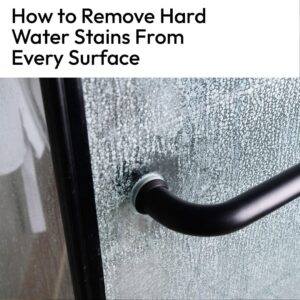ADVERTISEMENT
A Guide to Removing Hard Water Stains from Any Surface
Hard water stains—those unsightly, chalky marks that appear on your faucets, shower doors, and glassware—can be a major nuisance around the house. If you’ve been dealing with stubborn, mineral-based stains and haven’t found a way to eliminate them, you’re not alone. But fear not! Removing hard water stains doesn’t require expensive cleaners or harsh chemicals. With the right knowledge and some common household ingredients, you can get your surfaces looking shiny and clean in no time. Let’s dive into how to tackle those hard water stains once and for all!
What Are Hard Water Stains?
Hard water stains occur when water rich in minerals, such as calcium and magnesium, evaporates and leaves behind mineral deposits on your surfaces. Over time, these deposits accumulate, leaving behind stubborn spots that are difficult to remove. You’ll typically find hard water stains on:
- Shower doors
- Bathroom faucets
- Kitchen sinks
- Glassware
- Toilets
- Windows
- Tiled surfaces
Simple Methods to Remove Hard Water Stains from Different Surfaces
1. Glass Surfaces (Shower Doors, Windows, Glassware)
If you’ve got those cloudy, streaky hard water stains on your shower doors, mirrors, or glassware, here’s a simple and effective solution.
What you need:
- White vinegar
- Water
- Spray bottle
- Microfiber cloth or paper towels
- Baking soda (optional for tough stains)
Instructions:
- Mix a Cleaning Solution: Fill a spray bottle with equal parts white vinegar and water.
- Spray and Wait: Generously spray the solution onto the stained glass surface. Let it sit for about 10–15 minutes to allow the vinegar to break down the mineral deposits.
- Scrub: After the wait, use a microfiber cloth or paper towels to gently scrub the surface. You should see the stains start to lift away.
- Tough Stains? For more stubborn stains, sprinkle baking soda directly onto the surface before spraying the vinegar solution. The combination of vinegar and baking soda will help lift and dissolve even the toughest buildup.
- Rinse and Dry: Rinse the surface with water and dry with a clean cloth to prevent new streaks.
2. Faucets and Fixtures (Metal, Chrome, or Stainless Steel)
Hard water stains on metal faucets or fixtures can leave them looking dull and tarnished. Fortunately, a simple acid-based cleaner can work wonders.
What you need:
- White vinegar
- Small bowl or dish
- Cloth or sponge
- Baking soda (for stubborn stains)
Instructions:
- Soak the Area: Pour a little white vinegar into a bowl, then soak a cloth in the vinegar and wrap it around the affected area of the faucet or fixture.
- Let it Sit: Leave the cloth on for about 10-15 minutes to let the vinegar work its magic on the mineral buildup.
- Scrub: After soaking, use a soft cloth or sponge to scrub the area. For spots that don’t come off easily, sprinkle baking soda directly on the sponge or faucet, and scrub gently.
- Rinse and Polish: Rinse the faucet with water and dry it thoroughly with a clean cloth to restore its shine.
3. Bathroom and Kitchen Sinks (Porcelain or Ceramic)
Sinks are one of the most common places to find hard water stains, especially around the drain and faucet areas.
What you need:
- White vinegar or lemon juice
- Baking soda (optional)
- Sponge or scrubbing brush
Instructions:
- Apply the Vinegar: Spray or pour white vinegar or lemon juice directly onto the stained area. These acidic solutions will help dissolve mineral deposits.
- Let it Sit: Allow the vinegar or lemon juice to sit for 10–15 minutes to soften the buildup.
- Scrub: Use a sponge or soft brush to scrub the stained areas. For any particularly stubborn spots, sprinkle baking soda on top of the vinegar or lemon juice for extra scrubbing power.
ADVERTISEMENT
ADVERTISEMENT
